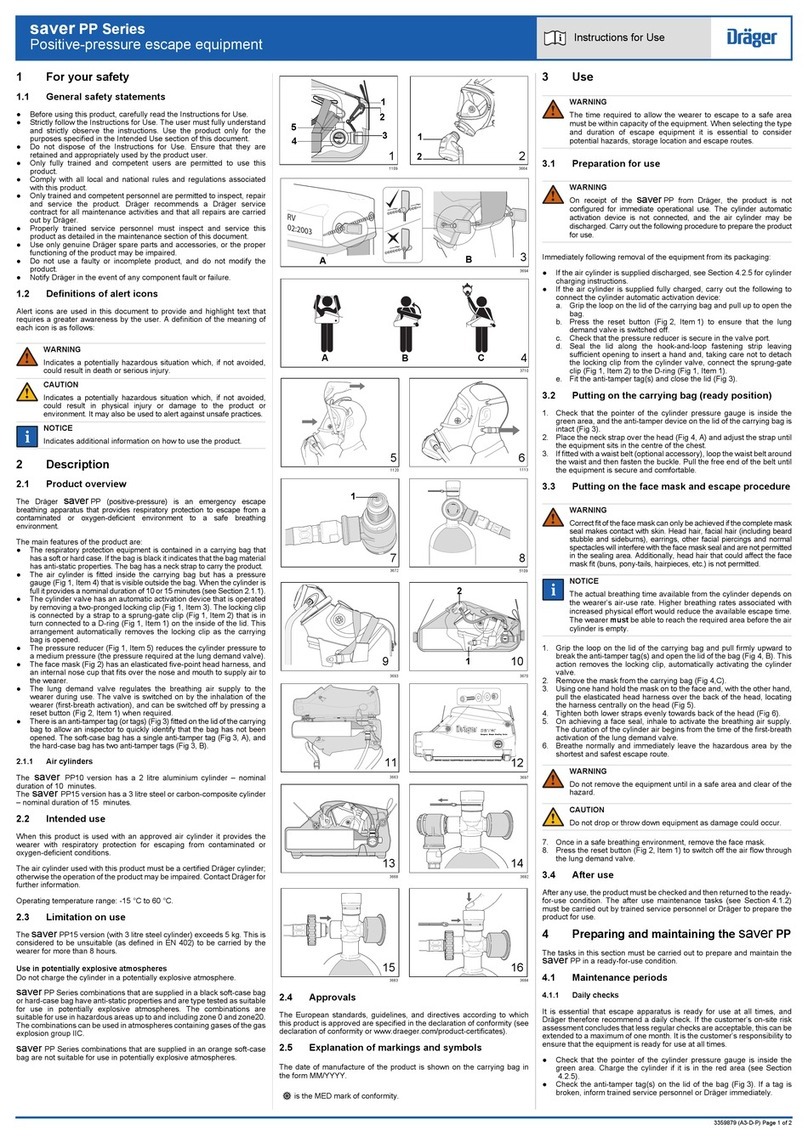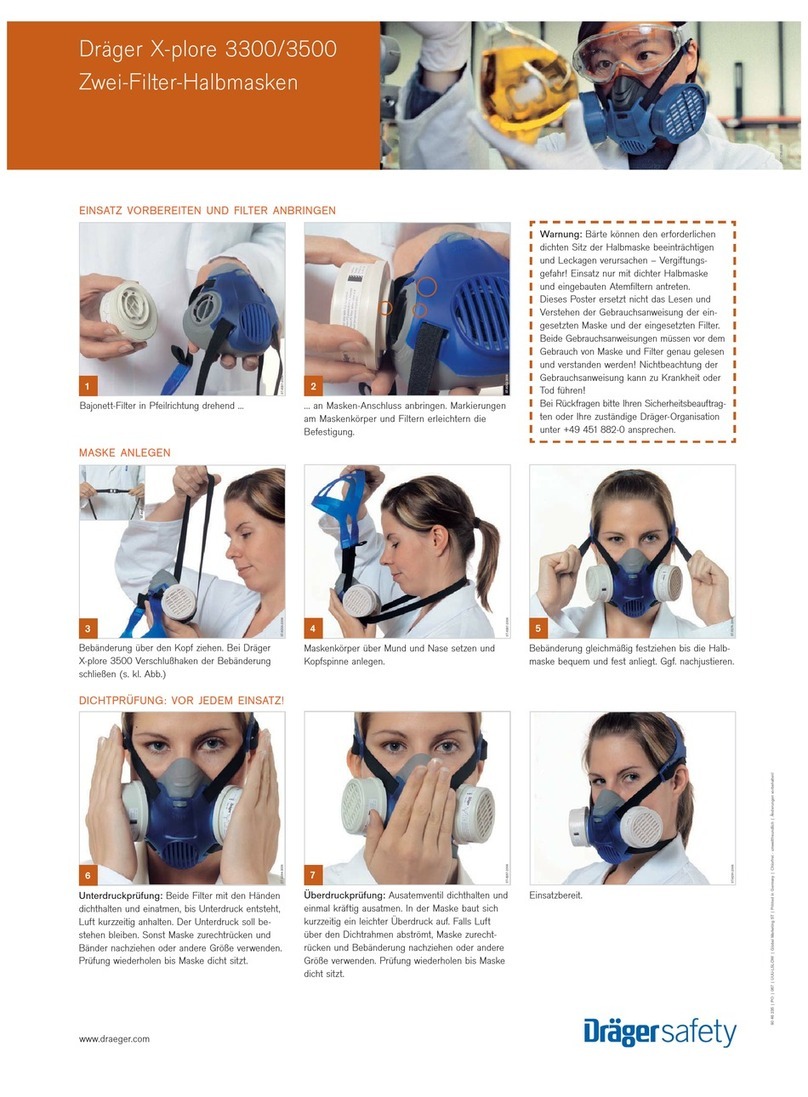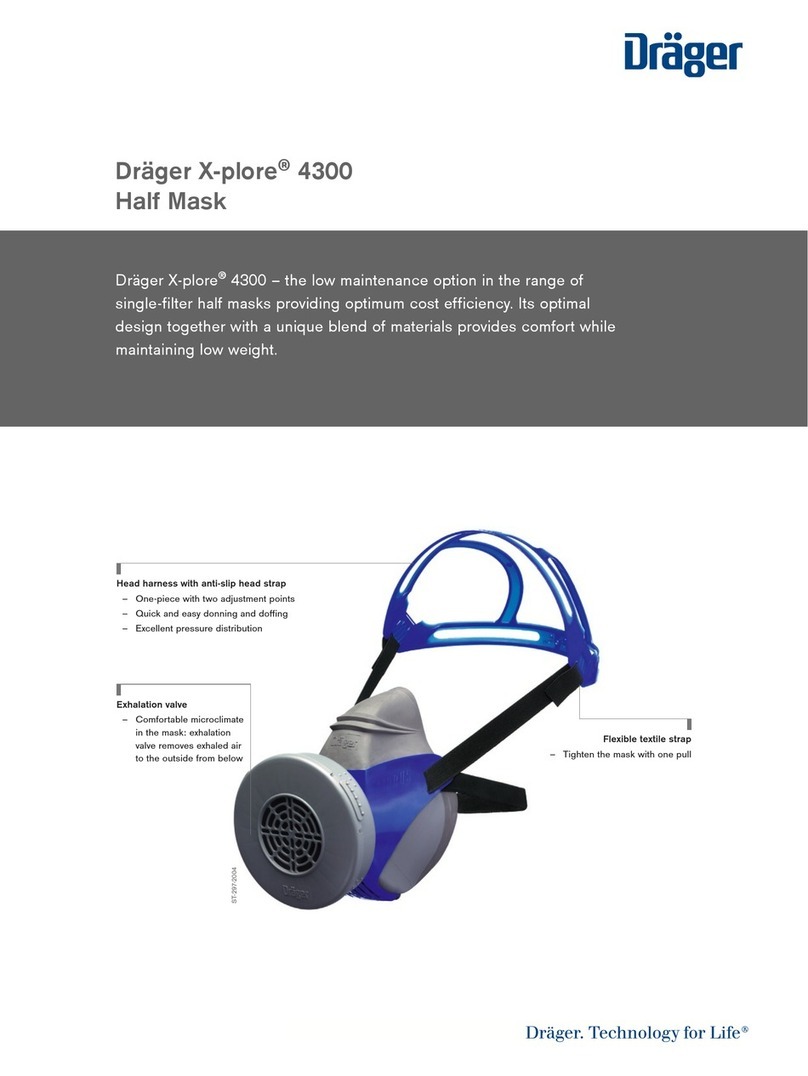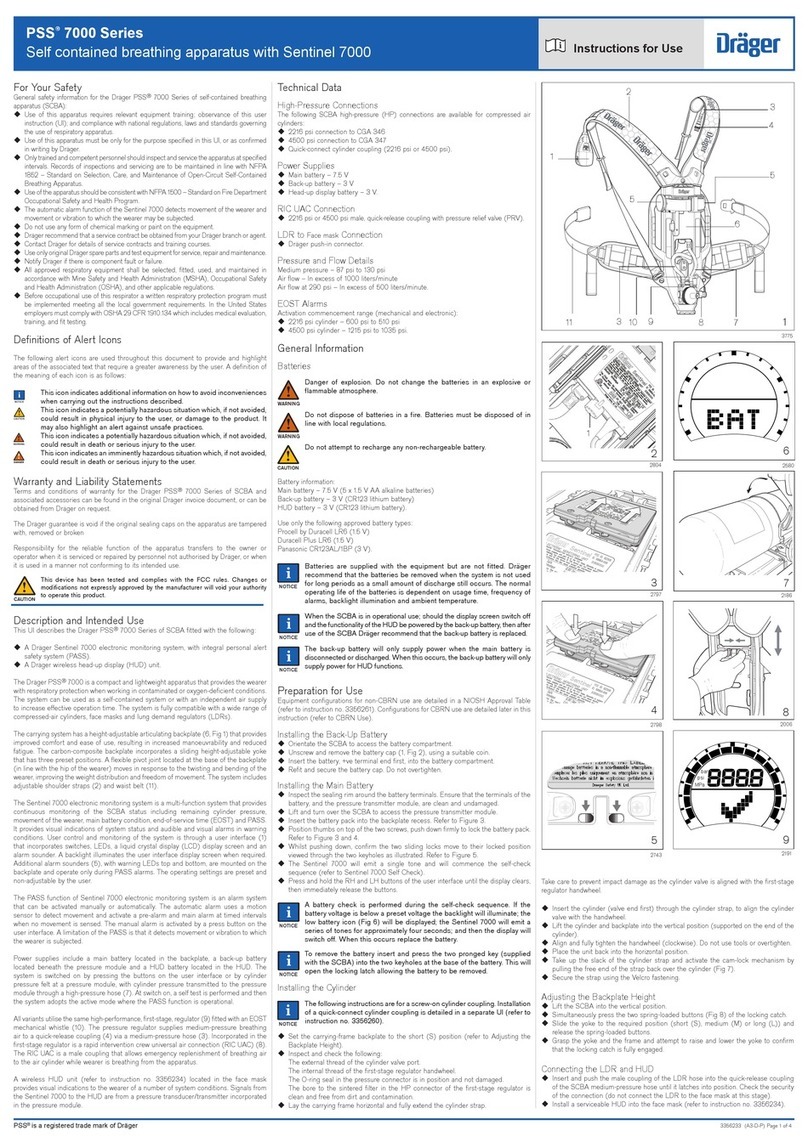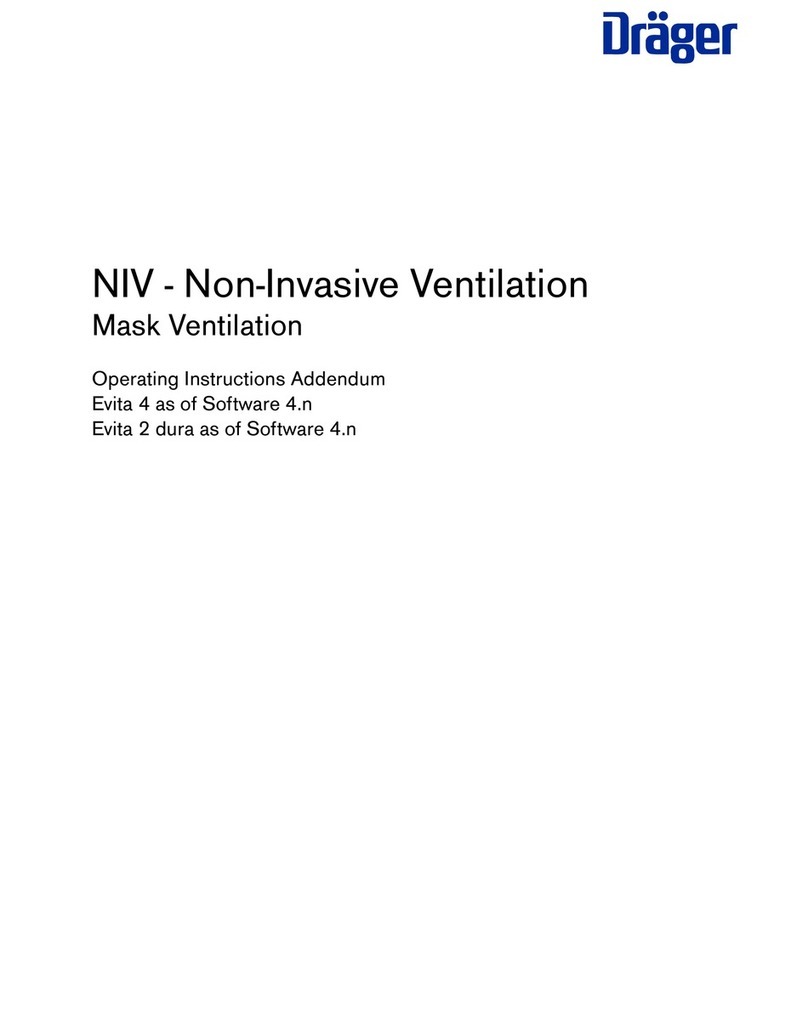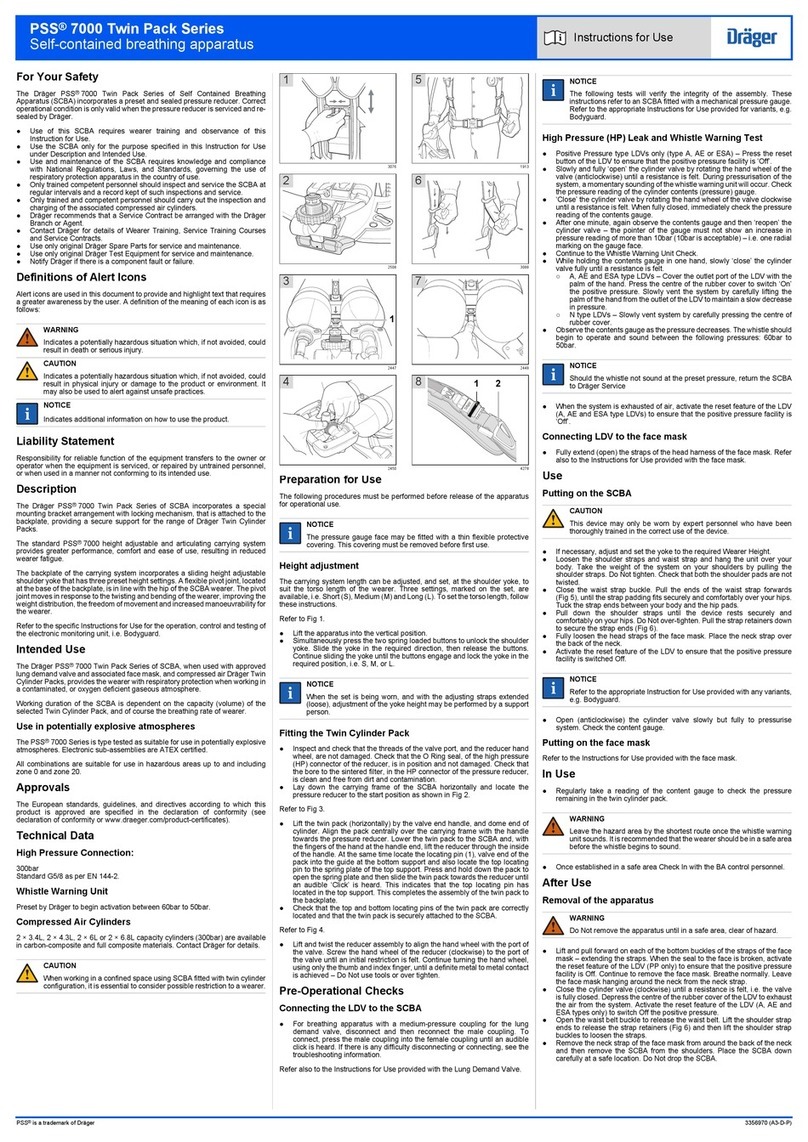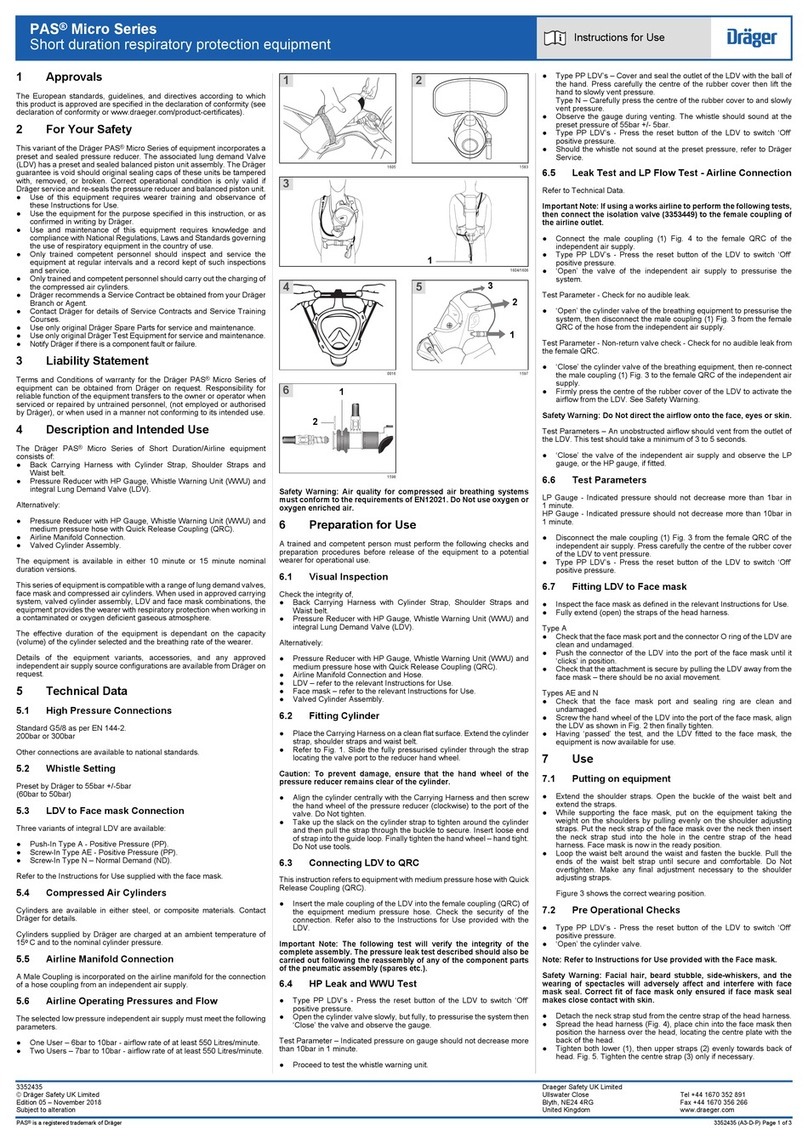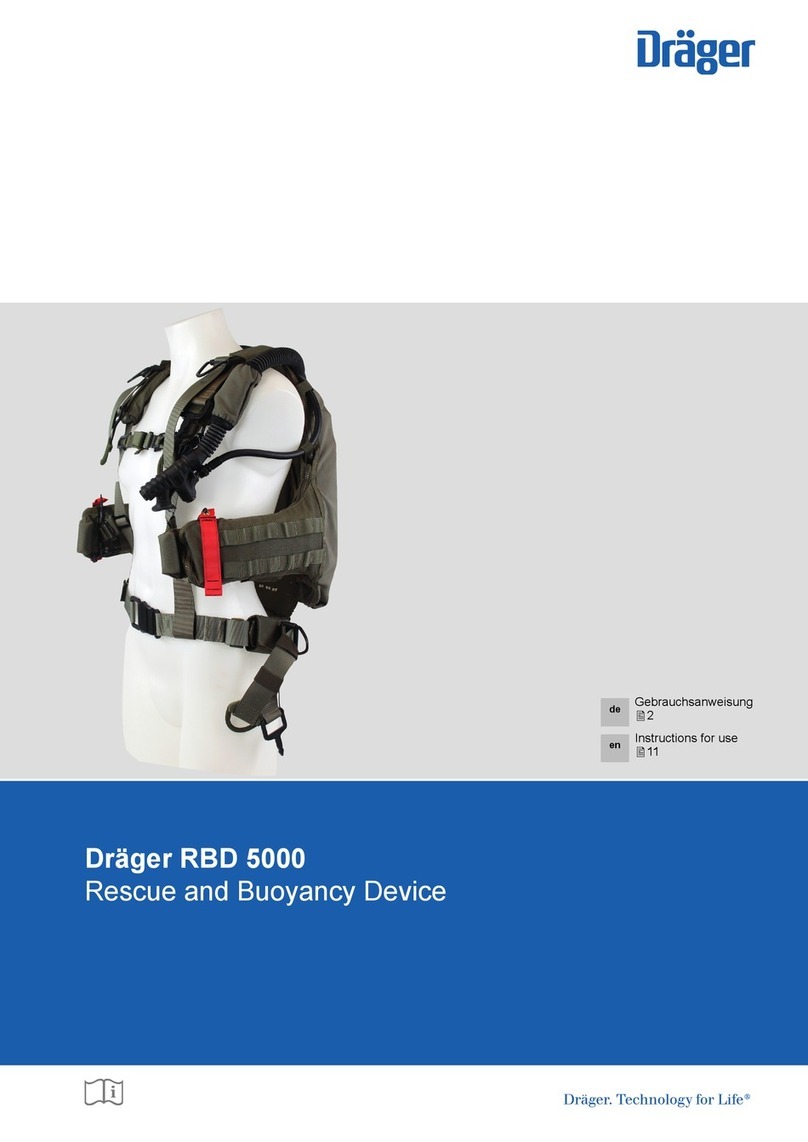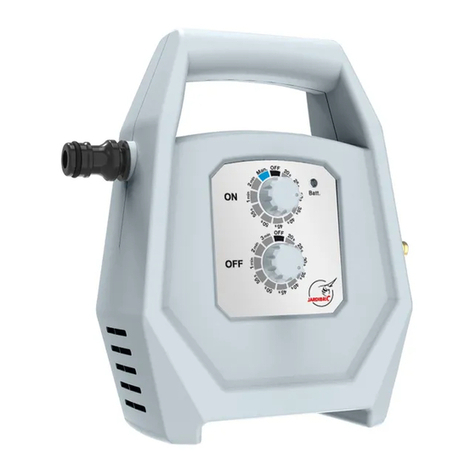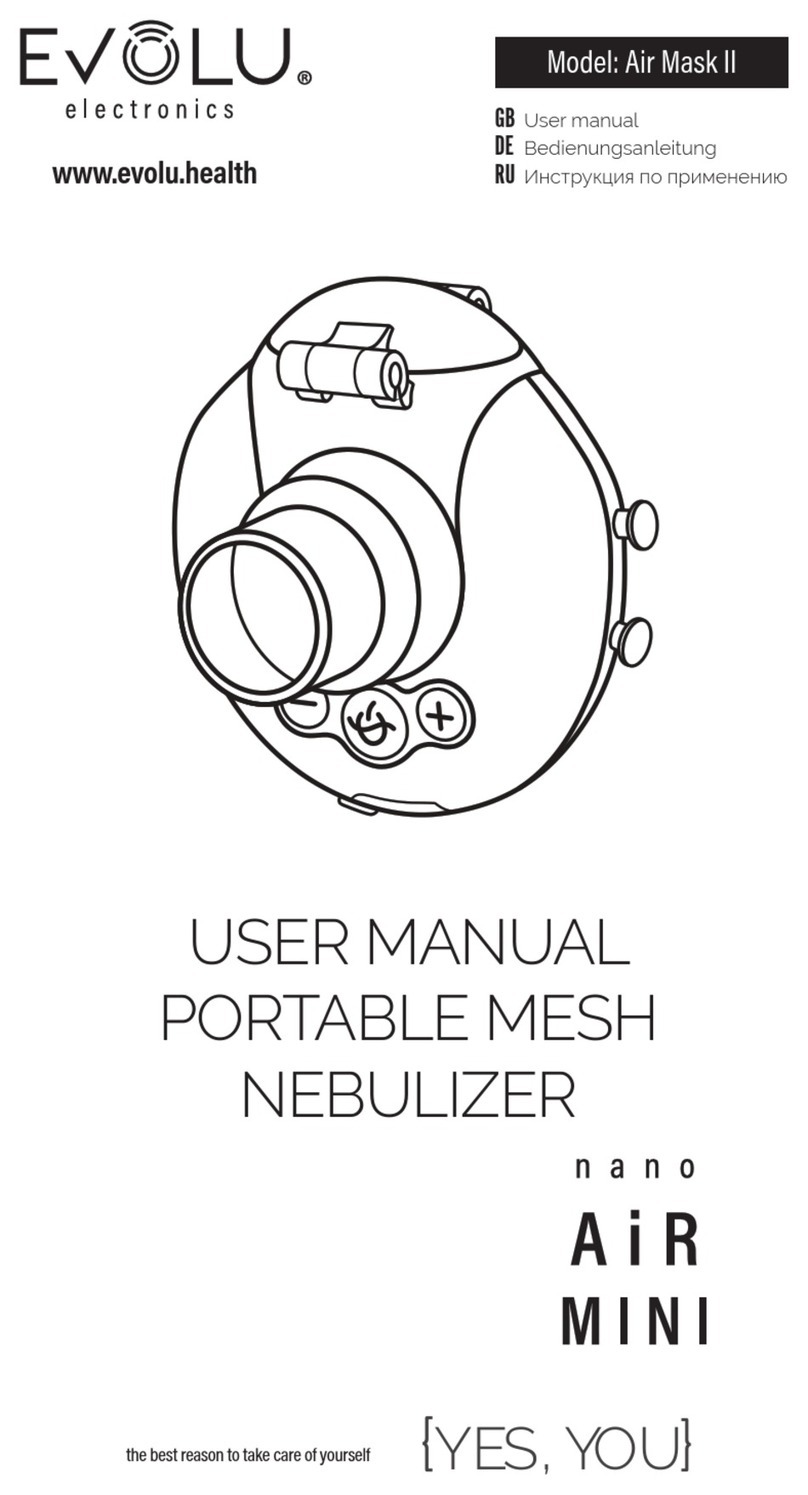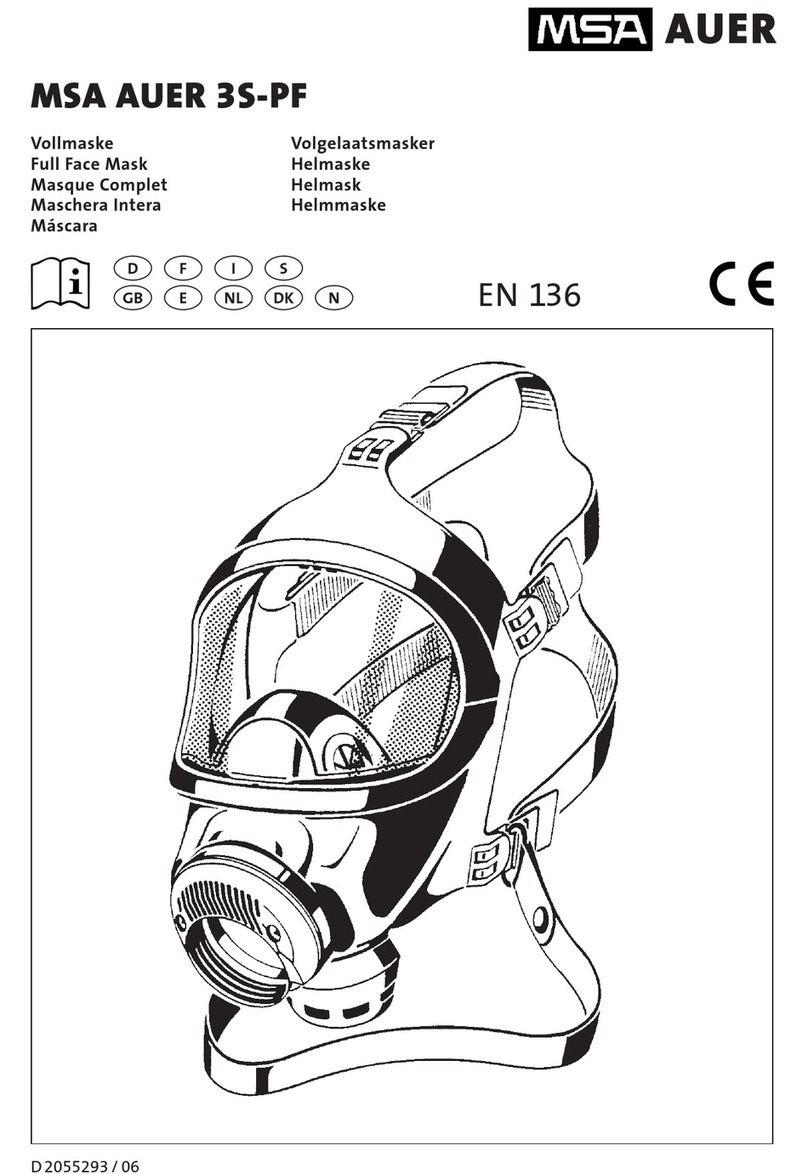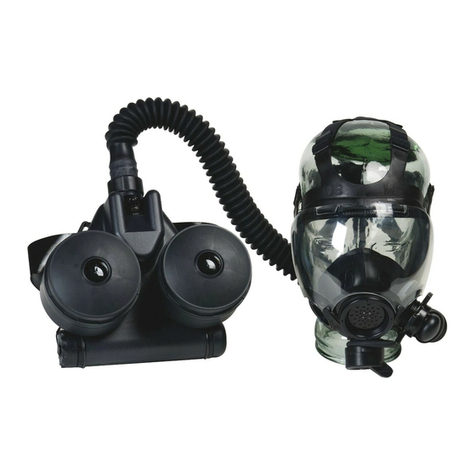
X-plore® 9300
Belt set Instructions for use
3363102 (A3-D-P)
1 Safety-related information
● Before using this product, carefully read the instructions for use.
● Strictly follow the instructions for use. The user must fully understand and
strictly observe the instructions. Use the product only for the purposes
specified in the intended use section of this document.
● Do not dispose of the instructions for use. Ensure that they are retained and
appropriately used by the product user.
● Only trained and competent users are permitted to use this product.
● Comply with all local and national rules and regulations associated with this
product.
● Only trained and competent personnel are permitted to inspect, repair and
service the product. Dräger recommend a Dräger service contract for all
maintenance activities and that all repairs are carried out by Dräger.
● Use only genuine Dräger spare parts and accessories for maintenance
work. Otherwise, the proper functioning of the product may be impaired.
● Do not use a faulty or incomplete product. Do not modify the product.
● Notify Dräger in the event of any component fault or failure.
The latest version and other translations of these instructions for use
can be downloaded in electronic form from the Technical
Documentation database (www.draeger.com/ifu). In light of product
updates, Dräger recommend always using the latest version of the
instructions for use.
2 Conventions used in this document
2.1 Meaning of the warning indicators
Warning indicators are used in this document to provide and highlight text that
requires a greater awareness by the user. The meaning of each of the warning
indicators is defined as follows:
WARNING
Indicates a potential hazardous situation which, if not avoided, could
result in death or serious injury.
CAUTION
Indicates a potentially hazardous situation which, if not avoided, could
result in physical injury, or damage to the product or environment. It
may also be used to alert against unsafe practices.
NOTICE
Indicates additional information on how to use the product.
2.2 Trademarks
The following internet page lists the countries in which Dräger trademarks are
registered: www.draeger.com/trademarks.
3 Description
3.1 Product overview
The Dräger X-plore 9300 (Fig. 1) is a belt-mounted manifold that connects an
external breathing air supply (airline) with a facepiece worn by the user. The
manifold has an input connection (5) for connecting the airline and an output
connection (4) for connecting the facepiece by means of a corrugated hose (3)
with a quick connect coupling at each end. The manifold is equipped with a
sound dampener pressed onto the upper part of the output connection. It serves
to reduce the ventilation noise in the facepiece.
During use, a pressure reducer in the manifold delivers a steady flow of air from
the airline into the facepiece. The air flow lies within the safe limit values
required by the facepiece. The X-plore 9300 is available with or without an
adjustable regulator valve (2). Once installed, the regulator valve lets the
wearer of the device adjust the flow of air within the preset limit values.
The whistle (1) is a warning device for low input pressure. The whistle will sound
during use to alert the wearer in the event that the pressure of the breathing air
supply falls below the level necessary for a sufficient supply.
The X-plore 9300 is used with the facepiece of the Dräger X-plore 8000 along
with hoods and protective helmets. The compatible Dräger hoods and Dräger
helmets are classified according to the following table.
For a complete description of the facepiece, see the instructions for use
supplied with the facepiece.
This device is available with optional radio frequency identification (RFID) to
facilitate electronic management and location of devices by means of a radio
frequency reader. When fitted, the passive RFID tag is positioned inside the
manifold casing.
3.1.1 Breathing air supply
The breathing air supply (supply from an airline) is an external breathing air
source that is fed from a breathing air cylinder or a compressor unit; the
breathing air supply delivers the specified air quality with the required pressure
and required flow rate (see section 4.1 for more information).
3.2 Intended use
The X-plore 9300 is designed for use with compressed air respiratory protection
equipment approved by Dräger. It protects the respiratory system from the
effects of hazardous materials. The equipment is only suitable for use with an
airline.
The compressed air respiratory protection equipment and other accessories used
with this device must be certified Dräger components that are used in the
approved configuration. Failure to comply with this requirement can impair the
operation of the device. Contact Dräger for further information.
Use in potentially explosive atmospheres
The suitability for use in potentially explosive atmospheres depends on the
components used. Approval information is specified on the component name
plates. The component with the lowest zone determines the suitability of the
system.
Contact Dräger for more information.
3.3 Limitations on use
The device is not suitable for CBRN hazard situations (chemical, biological,
radiological and nuclear hazard situations).
3.4 Approvals
This product is approved per:
● EN14594:2018
● (EU) 2016/425
● Regulation 2016/425 on personal protective equipment, as amended to
apply in GB
● AS/ NZS 1716:2012
Declarations of conformity: see www.draeger.com/product-certificates.
Important notice regarding the Pressure Equipment Directive (German: DGRL):
The X-plore 9300 is intended for exclusive use with compressed air hose
equipment. It is classified as safe pressure equipment according to the DGRL
under the requirement of good engineering practice. The equipment cannot be
DGRL-certified.
3.5 Marking and symbols
The product type is specified on the label on the manifold casing. The product's
serial number is located on the manifold.
The marking on the air supply hose indicates whether the hose is heat
resistant (H) and/or antistatic (S).
4Use
4.1 Breathing air supply
WARNING
The quality of the breathing air supply must meet the requirements for
breathing air in accordance with EN 12021 in EU countries or AS/
NZS 1715 2009 in Australia and New Zealand. Do not use oxygen or
oxygen-enriched air. The moisture content of breathing air should,
unless otherwise indicated, be kept within the specified limits in order
to prevent the equipment from freezing.
Carry out a risk assessment of the workplace to ensure that it is not
possible to connect to any breathing air supply other than breathable
air.
In highly toxic atmospheres, the device might not offer sufficient
protection.
The user must ensure that the capacity of the respiratory protective
device is sufficient for every user who is connected to it. The user must
also ensure safe exits in case of a failure of the breathing air supply
from the airline.
Use either a breathing air cylinder with a pressure reducer or a stationary or
mobile compressor with an appropriate filter system and air-heating / air-cooling
system. Compliance of the breathing air supply with the quality criteria is
mandatory. It must meet the following requirements for pressure and flow:
● Input pressure 2.8 to 10 bar
● Input flow 200 to 1200 litres/minute (to guarantee the entire
flow range in models with a regulator valve, at least
350 litres/minute are necessary)
For the maximum number of users who can be connected to the Dräger
breathing air supply system at any one time, refer to the instructions for use for
the supply equipment.
It must be possible to move the air supply around a hazardous area if using a
breathing air cylinder arrangement. Conductive floors are mandatory in zone 1
and zone 21 if combustible dusts with a minimum ignition energy of less than
10 mJ are present.
4.1.1 Compressed air supply hose
● The coupling of the airline must be compatible with the coupling at the inlet
of the device. Unless specified otherwise, the inlet is outfitted with a
coupling from the Rectus 96 Series or a male type CEJN quick connect
coupling (Dräger also provides other couplings).
● The maximum working pressure of the Dräger compressed air supply hose
is 10 bar.
● Ensure that supply hoses with a total length greater than 50 m have an
appropriate earth connection.
EU countries
When using a Dräger-approved hose: The hose must not be longer than 100 m
and at most four individual hoses (maximum five hose connections) may be
connected to the airline.
Australia and New Zealand
Approved hoses must be used in order to comply with the AS/NZS regulatory
standard. Hoses between 5 and 30 m, or up to 90 m of connected hoses may
be used.
4.1.2 Pressure drop in the compressed air supply hose
CAUTION
The use of extension hoses causes a pressure drop between the
breathing air supply and the manifold.
► To compensate for the resulting pressure drop, increase the
pressure from the breathing air supply (e.g. ring pipe, compressor)
accordingly.
The following table is a guide that lists examples of breathing air supply
pressures necessary so that a sufficient flow of air is available at the manifold
inlet.
This table only applies if using approved Dräger supply hoses. If using hoses
from other manufacturers, the minimum pressure of 2.8 bar must be available
at the manifold inlet.
Trademark Trademark owner
X-plore®Dräger
Product
type
Facepiece Class per
EN 14594:2018
Helmets Helmet L1Z (3710775),
helmet with visor (R58325/
R59910), protective visor (R59900)
2B
Helmet L3Z (3710785) 3B
Helmet L2Z (3710780) 4A/3B
Helmet L2T2 (3710790),
helmet L3T4 (3710795),
hood T2 (3710776),
hood T4 (3710774)
4A/3B
Hoods R59800, R59810, R59820,
R59830, R59840, R59850,
R59860, R59870
3B
!
!
i
i
Approved body:
BSI Assurance UK Ltd.
Kitemark Court Davy Avenue
Knowlhill
Milton Keynes
MK5 8PP
United Kingdom
Identification number:
Notified body
involved in type approval and quality
control:
DEKRA EXAM GmbH
Dinnendahlstr. 9
44809 Bochum
Germany
Reference number:
Hose lengths in
metres
Pressure in bar Hose lengths in
metres
Pressure in bar
1-10 3.1 51–60 4.6
11-20 3.4 61-70 4.9
21-30 3.7 71-80 5.2
31-40 4.0 81-90 5.5
41-50 4.3 91-100 5.8
0086 0158
!
!
4439
4440
4528
4442 4429
4446





